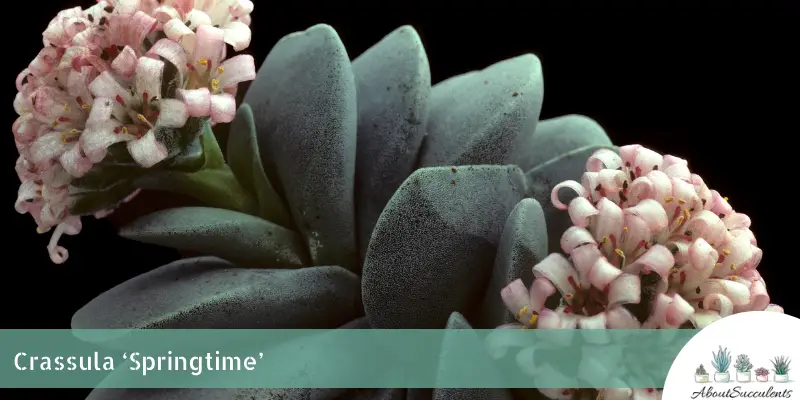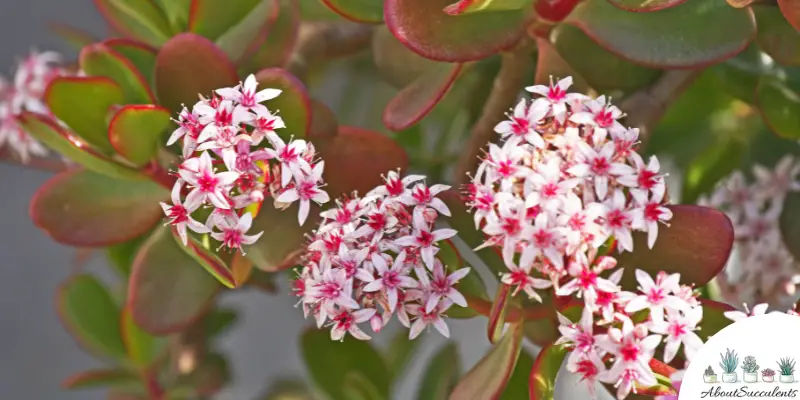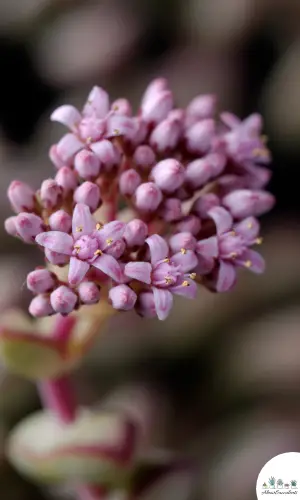
Crassula “Springtime” is an enchanting succulent plant that blooms charming small, pink-colored flowers in the late winter and early spring months. Springtime is native to South Africa and is a member of the Crassulaceae family.
Crassula Springtime can grow to a height of 20cm (8”) tall with a width of 15cm (6”). This type of succulent is known to be slow-growing and as the stems grow, they begin to bend because the plant becomes heavier.
The leaves of Springtime are fleshy, have an elliptical shape, and the edges have a rough texture. The color of the leaves will vary from light to dark green.
General Information:
Also known as: Springtime Crassula
Plant Family: Crassulaceae
Origin: South Africa
Height: 20cm (8-inches)
Exposure: 6 hours of direct sun
Water Needs: Use the soak and dry method and give the soil a lot of water when the soil is 100% dry.
Soil Type: Cactus mix with pumice or perlite for better drainage.
Soil pH: 6.5 to 7.0
How to Grow and Care for Crassula “Springtime”

Are you looking for ideas on how to grow Crassula “Springtime”? Adorn your container garden with this trailing succulent. When the rosettes become too heavy for the plant, they will fall and present a wonderful trailing cascade down a hanging basket.
Springtime Crassula is also easy to care for. You won’t have a hard time growing this succulent plant into a magnificent beauty.
Sunlight
Crassula Springtime loves the sun.
As an outdoor succulent, make sure Springtime is located in an area that gets 6 hours of direct sunlight.
This is not a cold-hardy succulent and if the temperature in your region falls below -1.1° C (30° F), it would be best to grow Springtime in a pot or hanging container that can be relocated indoors.
When indoors, the plant must be located near a window that receives at least 6 hours of sunlight. Partial sunlight will be fine but Springtime will grow better under direct sunlight.
Watering

Give Crassula Springtime water only when the soil is 100% dry. If you water the soil while it still retains moisture, the roots will be at risk of rotting.
To find out if it’s time to water Springtime, insert a stick an inch into the soil. If the stick feels dry after you pull it out, then you can prepare the soil for watering.
The best way to water is to give the soil – not the plant – thorough soaking. Never water the plant directly as this can lead to longer retention of moisture. If the leaves have a type of fungal infection, the water can carry the bacteria to the nearby plants.
The summer and spring months will have you water the soil more frequently as it will dry out faster. In contrast, expect to water the soil less in the wintertime because it will retain moisture longer.
Pot and Soil
The best choice of pot for Springtime is one that’s made of either ceramic or terracotta and it must have good drainage at the bottom. Again, the purpose is to dry out the soil as fast as possible.
Ceramic and terracotta have been found to support the fast evaporation of water from the soil. It’s best to re-pot Springtime to a larger pot every 2 to 3 years to give its roots more aeration in the soil.
Crassula Springtime is a durable succulent and doesn’t require high-quality soil with good nutrients. All it requires is soil that has good drainage such as cactus mix which is very porous. You can add other ingredients such as perlite and pumice to improve drainage.
Fertilizer is not needed for Springtime that’s grown outdoors. For indoor Crassula Springtime, we recommend adding fertilizer to the soil only during spring and never in the wintertime.
How to Propagate Crassula “Springtime”
Even if Crassula Springtime is a slow-growing type of succulent, you can still successfully propagate the species using either the leaf or stem cuttings method.
Method 1: Leaf Cuttings
Step 1: Find a healthy leaf and perform a clean twist and pull from the stem. You can also use a sharpened and sterilized knife of garden shears to make sure no part is left on the stem.
Step 2: Allow the leaf cuttings to develop calluses by placing them in a clean and dry area for 2 to 3 days.
Step 3: When the leaf cuttings have callused over, place them on top of well-draining soil.
Step 4: Keep the soil slightly moist by misting it every day.
Step 5: When the roots have taken growth in the soil, only give water when the soil is completely dry.
Method 2: Stem Cuttings
Step 1: Choose a healthy-looking stem near the main plant.
Step 2: Cut off the stem with a sharpened and sterilized pair of garden scissors.
Step 3: Let the stem cuttings develop calluses over a period of 2 to 3 days.
Step 4: Plant the stem cuttings on well-draining soil.
Step 5: Lightly mist the soil until the roots have taken hold. From there, only give the soil water when you’re sure it’s bone dry.
Frequently Asked Questions
Is Crassula “Springtime” Toxic to Cats and Dogs?
Crassula “Springtime” is not listed among the plants that are toxic to cats and dogs in the website of the American Society for the Prevention of Cruelty to Animals (ASPCA).
There are reports that reveal Springtime can be toxic to animals. Don’t take chances and keep this succulent out of reach of your pets.
Why Is My Crassula “Springtime” Dying?
Crassula Springtime is easy to care for but if you overwater the soil and allow pests to nestle in the leaves, these incidents can cause its death.
Overwatering
Crassula Springtime is durable but it’s susceptible to developing fungal growth because of overwatering.
If the roots rot, it will develop an infection that can rapidly spread throughout the plant. A tell-tale sign of infection is a discoloration of the leaves or parts of the stem.
To keep the infection from spreading further, cut off the infected parts with a sterilized garden knife or scissors. Remove the plant from the soil and cut off the infected roots.
Prepare Springtime for repotting by filling up a new pot with a fresh well-draining cactus mix. Repot Springtime Crassula and only water when absolutely necessary.
Pest Infestation
Pests such as mealybugs, aphids, and spider mites can invite themselves to live inside Crassula Springtime and drink its nutritious sap. These pests will not only drain your plant of valuable sap but can cause fungal infection.
Remove all infected parts of the plant with a pair of sterilized garden shears. Clean and disinfect the leaves with 70% isopropyl alcohol then spray the succulent with neem oil to keep the pests away.
Does Crassula “Springtime” Produce Flowers?
Yes, Crassula Springtime blooms beautiful, small, and pink-colored flowers near the end of winter or the start of spring.
Last Updated on June 9, 2022 by Sofia Lara